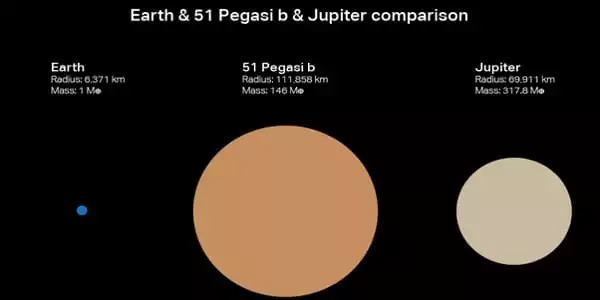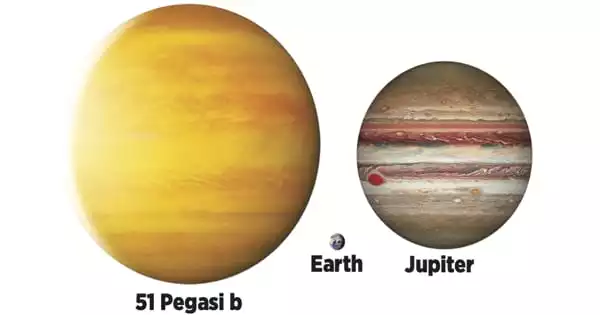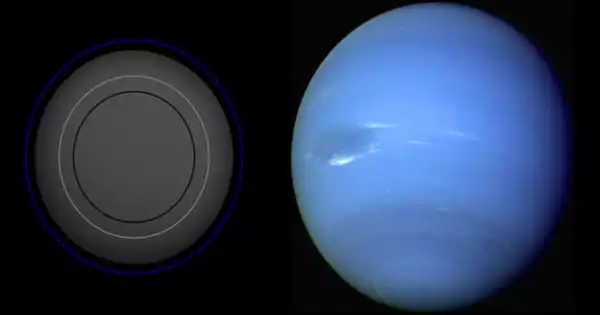51 Pegasi b is an extrasolar planet located in the constellation Pegasus about 50 light-years away. It was the first exoplanet discovered orbiting a main-sequence star, the Sun-like 51 Pegasi, and it represented a significant advance in astronomical research. The letter b indicates that this planet was the first to be discovered orbiting its parent star. If more planets are discovered for the star 51 Pegasi, they will be labeled c, d, e, f, and so on. This planet is the only one known in this system so far. It is the prototype for a type of planet known as a hot Jupiter.
Astronomers officially named the new planet 51 Pegasi b, in accordance with extrasolar planet nomenclature already established. Water traces were discovered in the planet’s atmosphere in 2017. The discovery of 51 Pegasi b was recognized with a Nobel Prize in Physics in 2019. 51 Pegasi b, the first exoplanet discovered orbiting a sun-like star, challenged our understanding of the universe and sparked the search for new worlds.
51 Pegasi b is an extrasolar planet approximately 50 light-years away in the constellation of Pegasus. It is the prototype for a class of planets called hot Jupiters.
Name
Other names for 51 Pegasi b have been proposed by astronomers. Geoffrey Marcy, an astronomer who helped confirm its existence and followed the convention of naming planets after Greek and Roman mythological figures, gave it the name Bellerophon.
The host star’s Flamsteed designation is 51 Pegasi. Michel Mayor and Didier Queloz, who discovered the planet in December 1995, named it 51 Pegasi b at the time. The following year, astronomer Geoffrey Marcy, who followed the convention of naming planets after Greek and Roman mythological figures, unofficially dubbed it “Bellerophon” (Bellerophon was a figure from Greek mythology who rode the winged horse Pegasus).
The International Astronomical Union launched NameExoWorlds in July 2014, a process for naming specific exoplanets and their host stars. The new names were chosen through public nomination and voting. Dimidium was chosen as the winning name for this planet by the International Astronomical Union in December 2015. The Astronomische Gesellschaft Luzern (German for “Lucerne Astronomical Society”) in Switzerland proposed the name. ‘Dimidium’ is Latin for ‘half,’ referring to the planet’s mass, which is roughly half that of Jupiter.

Discovery
51 Pegasi b is the first confirmed extrasolar planet to orbit a sunlike star. The planet orbits 51 Pegasi, a fifth-magnitude star 48 light-years from Earth in the constellation Pegasus. Michel Mayor and Didier Queloz of the University of Geneva announced the discovery of the exoplanet in the journal Nature on October 6, 1995. They used the radial velocity method with the ELODIE spectrograph on the Observatoire de Haute-Provence telescope in France, and their announcement made international headlines. They were awarded the 2019 Nobel Prize in Physics for this discovery.
The planet was discovered using a sensitive spectroscope that detected the star’s spectral lines’ slight and regular velocity changes of around 70 meters per second. These changes are caused by the gravitational effects of the planet, which is only 7 million kilometers away from the star.
Physical characteristics
Many teams confirmed the planet’s existence and obtained additional observations of its properties after its discovery. The planet orbits the star in about four days, as discovered. It is much closer to it than Mercury is to the Sun, moves at a 136 km/s orbital speed, and has a minimum mass roughly half that of Jupiter. The presence of a massive world so close to its star was considered an anomaly at the time because it contradicted theories of planet formation. However, numerous other ‘hot Jupiters’ (such as 55 Cancri and τ Boötis) have been discovered since then, and astronomers are revising their theories of planet formation to account for them by studying orbital migration.
The temperature would be 1265 K (approximately 1000 °C / 1800 °F) if the planet was perfectly grey with no greenhouse or tidal effects and a Bond albedo of 0.1. This corresponds to the predicted temperatures of HD 189733 b and HD 209458 b (1180–1392 K) prior to measurement.
It was initially speculated in the discovery report that 51 Pegasi b was the stripped core of a brown dwarf of a decomposed star and thus composed of heavy elements, but it is now thought to be a gas giant. It is massive enough that the star’s solar wind does not blow away its thick atmosphere.
















